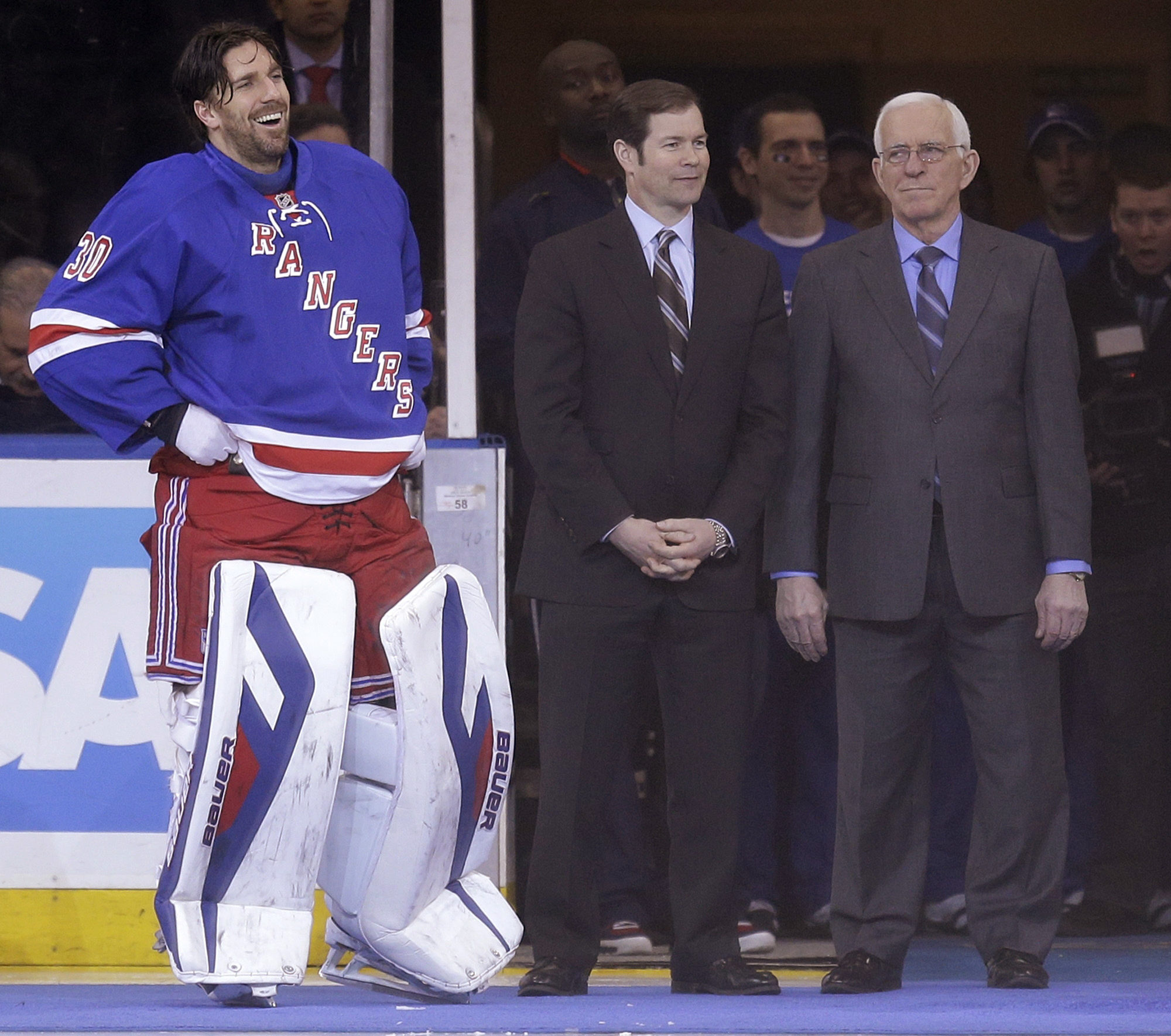As we celebrate the the Rangers’ 90th anniversary, a look back at the club’s array of starry goaltenders makes it a challenge to select a Top-9.
But with the help of my criteria — Hall of Famers, Stanley Cup-winners, Award-winners and clutch performers — I was able to accomplish the task.
I have listed them in alphabetical order but, this time, will not compare those mostly mask-less wonders with Henrik Lundqvist nor Antti Raanta because bygone goaltenders styles were so vastly different that those today.
Agree or disagree, let me hear from you with your opinions. Let’s stop the shot and go.
ANDY AITKENHEAD
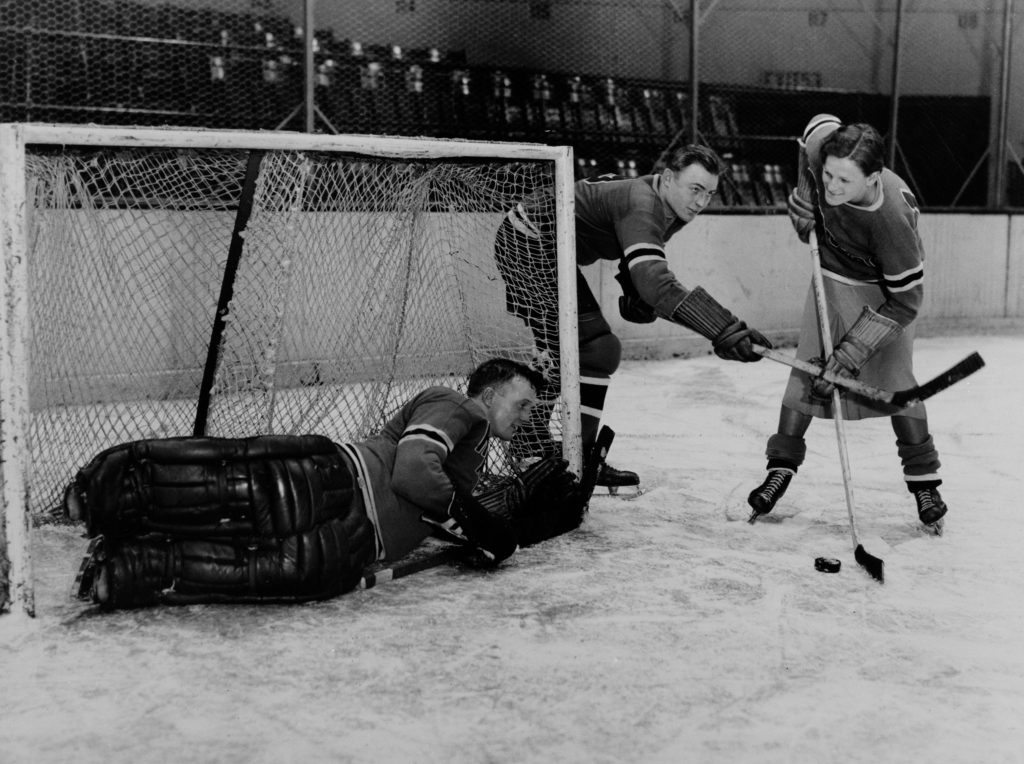
A goaltender only requires one amazingly outstanding season to qualify for this list and that explains why Andy Aitkenhead is here. A lifetime Ranger — although he only played three seasons as a Blueshirt — the Scottish-born netminder helped New York to its second Stanley Cup in 1933.
And, how about this; he did it in his rookie season! Playing in all 48 of the Rangers games, Aitkenhead produced a 2.23 goals against average and three shutouts. But it was in the playoffs that the puck-stopper excelled.
After the Blueshirts defeated the Montreal Canadiens and Detroit Red Wings in the preliminary rounds, they went up against the defending champion Toronto Maple Leafs. Facing Lorne Chabot, who had been the Rangers’ goalie in their first two seasons, Aitkenhead completely outdueled the veteran.
Andy allowed only one goal each in the Blueshirts first two victories — 5-1 and 3-1 — in the best-of-five Final. And after dropping Game 3, 3-2, he took a 0-0 draw into overtime before Rangers captain Bill Cook tallied the Cup-winner at 7:34 for the Gotham’s second Stanley Cup.
Aitkenhead, who liked to wear a dirty, worn cap when he played, led playoff goalies with six wins and a 1.62 goals against average helped by two shutouts. That’s the good news. The bad news is that he played only two more years in New York and spent the rest of his hockey life in the minors.
ED GIACOMIN
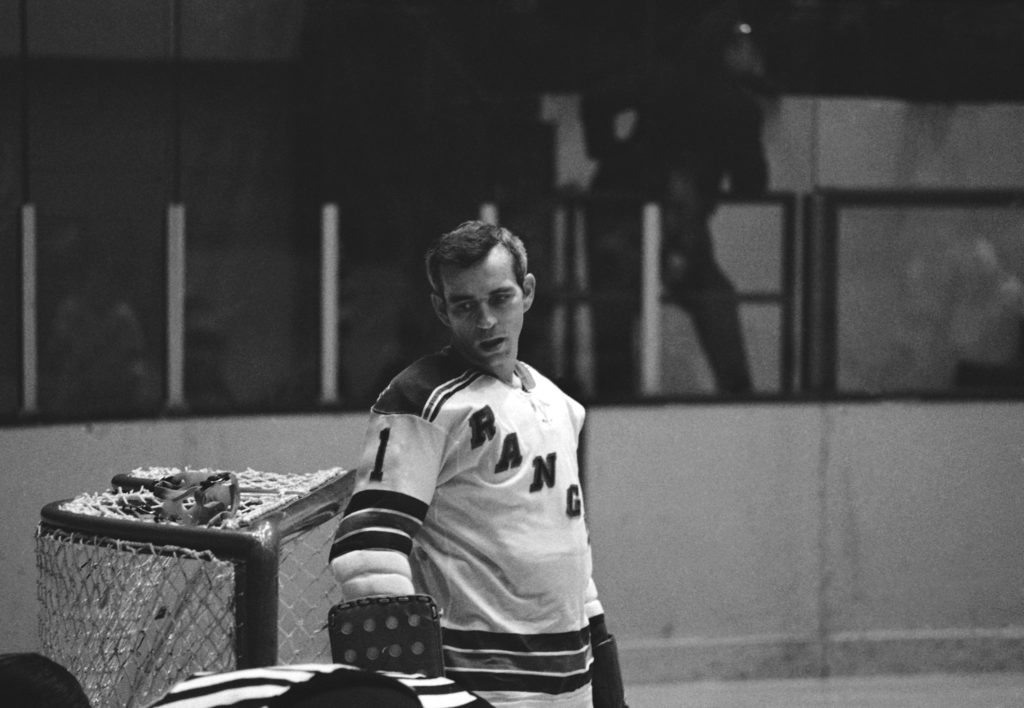
For sheer fan popularity, this “Goalie-Au-Go-Go,” as I once nicknamed him, ranked at the top of the Garden’s list. Feisty, fearless and loving to handle the puck, Giacomin came to New York after one of general manager Emile (The Cat) Francis‘ biggest deals in 1965. The Cat sent five players to Providence of the AHL for Eddie G.
At first, Giacomin struggled in his rookie season and occasionally was replaced by Cesare Maniago. But, in time, Eddie prevailed and became the solid goalie Francis had hoped he’d be.
In 1966, the Rangers’ brass staked everything they had on Giacomin. The team had finished out of the playoffs for the previous five years. Weak goaltending and poor defense were big factors.
Giacomin got the assignment and finished the season with a 2.61 goals-against average and a league-leading nine shutouts. The Rangers made the playoffs and Giacomin earned a berth on the First Team All-Star squad.
In 1970, the Rangers lost in the quarterfinals for the fourth straight year. People said that the reason the Rangers wilted in May was because Giacomin was dog-tired, the result of playing in excess of 60 games in an era of coast-to-coast scheduling.
But when all is said and done, Giacomin was a New York hero. As The Hockey News noted: “He accrued the wins and accolades (two-time first-team all-star, three-time second-teamer) and was a fan favorite, but he was a casualty of what some observers considered a ‘Rangers’ jinx.’ His nearest miss when it came to winning a Stanley Cup was a six-game loss to Bobby Orr and the Big, Bad Bruins in the 1972 Cup Final.”
[Look back at the rest of Stan’s 90th Anniversary Series]
JIM HENRY
After Davey Kerr retired a season after winning the Stanley Cup for New York, general manager Lester Patrick found a very competent replacement in the goalie nicknamed “Sugar Jim.” The rookie netminder exceeded expectations and paced the Blueshirts to first place in 1941-42, the last season of the seven team NHL. (The Rangers longtime Madison Square Garden rival, the New York Americans, folded after that campaign.)
Like so many Rangers, Sugar Jim joined the Canadian Armed Forces and returned after the war for the 1945-46 season. By that time the Blueshirts had acquired Charlie Rayner who was part of the distribution of New York Americans players. As it happened, Rayner and Henry were good friends and easily introduced the two-goalie system to the NHL as Rangers.
Ever more remarkable was the fact that coach Frank Boucher found Rayner and Henry so equal in ability that in one game at least, he had the goalies exchanging goal sticks — and places in the crease — with his line changes.
In that one-goalie era, Boucher had trouble deciding between Rayner and Henry. He decided to retain Rayner, trading Henry to the Chicago Blackhawks for the 1948-49 season.
DAVE KERR
It may not be the most famous New York Stanley Cup victory, but the 1940 edition certainly has become memorable as was the Rangers’ goalie, Davey Kerr who sipped the champagne. But before reaching New York, Toronto-born Kerr had to pay his NHL dues on two other teams.
Kerr broke into The Show in 1930-31 with the Montreal Maroons and spent one season (1931-32) with the New York Americans before returning to the Maroons for three more campaigns. The Rangers acquired him in 1934-35 as the Blueshirts began a long-term rebuilding program. His style and combat ability proved a boon to the New Yorkers.
Agile as a ballet dancer, Kerr could do a split with one skate firmly anchored against one goal post and the other skate stretching right across the goalmouth to the other post.
One of his favorite practice maneuvers was to lay his stick across the goalmouth in front of the goal line. Then he’d prop his left skate against the right post, thus spread-eagling his body across much of the net. This would leave his hands free to catch the puck and his stick to deflect pucks along the ice. Kerr would then dare his teammates to beat him.
“Kerr was gifted with an excellent right hand that picked off shots like Bill Terry playing first base for the Giants,” Frank Boucher said. He was deliberate and methodical in everything he did. Davey retired long before his time, when he was at his peak and only 30-years-old.
Rangers coach Frank Boucher observed; “In a commanding way, Davey was able to shout at his defensemen, giving them guidance without offending them, and getting them to do the job he wanted in front of him, talking continually when the puck was in our end. I don’t ever remember Dave accusing a defenseman for [making] a mistake when a goal was scored against him. He always assumed the blame.”
HENRIK LUNDQVIST
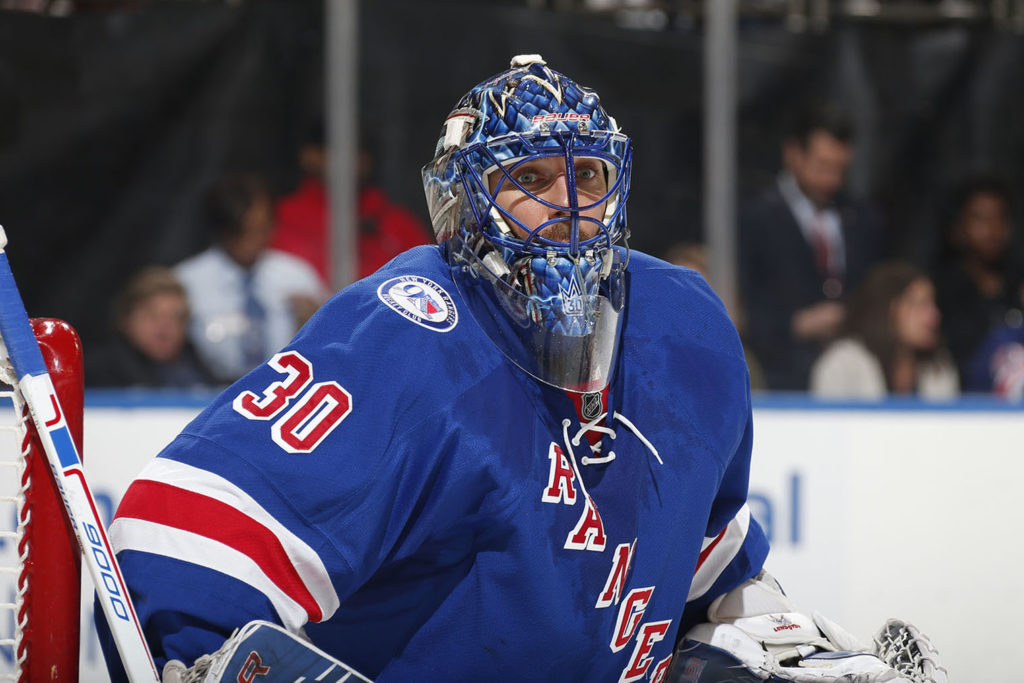
An unlikely starter when he became a Ranger in 2005, Lundqvist — alias King Henrik — has become one of the all-time New York sports icons in a class with Derek Jeter, Joe Namath, and Patrick Ewing. And this was not because of his good looks, even though Lundqvist has been voted the best-dressed player in the NHL.
His fame is directly related to his accomplishments on the ice. Originally drafted by the Blueshirts in the seventh round of the 2000 NHL Entry Draft, Lundqvist made his debut during the 2005-06 season and has been the unquestioned starting goaltender ever since.
Lundqvist has had seven Top 5 Vezina Trophy finishes, including winning the prestigious award for his efforts during the 2011-12 season. Of his 11 seasons that are already in the books, Lundqvist has backstopped the Blueshirts to the Stanley Cup Playoffs in 10 of those seasons; including, a recent run of reaching the Eastern Conference Finals in three of the past five seasons, which also included a run to the Stanley Cup Final during the 2013-14 season.
Lundqvist has been remarkably consistent throughout the course of his career, winning 20+ games in each of his 11 full seasons, and 30+ in 10 of 11 seasons, (2012-13 lockout-shortened season.) As such, Lundqvist is already the franchise leading goaltender in several key categories: wins (383) and shutouts (60).
In 2005, Kevin Weekes was supposed to the be the starting goaltender for the Blueshirts, but an untimely injury led to Lundqvist being pressed into the starting job. When Weekes had recovered from his injury, he had been bumped to the No. 2 goalie role.
While Hank has never won the Cup and wasn’t highly thought of coming into the 2000 NHL Entry Draft, Lundqvist has been nothing but a major success during his 12-year career. His high quality play continues through the current campaign.
CHUCK RAYNER
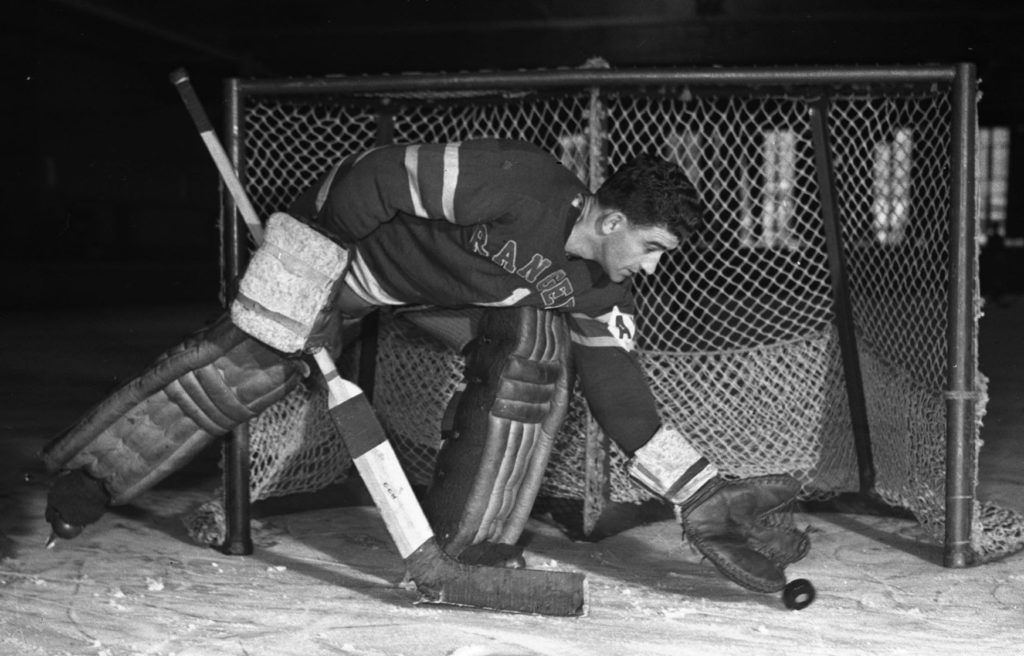
In the 1950 Stanley Cup Final, Chuck (Bonnie Prince Charlie) Rayner came within a hit goal post of winning the Stanley Cup. In the first overtime in Game 7 of the Final against Detroit, the Blueshirts’ Don Raleigh hit the goal post behind the Red Wings’ Harry Lumley. Alas, the Wings won the Cup on a goal in the second overtime period. But it was no fault of Rayner’s.
The bushy-browed, acrobatic netminder broke into the professional ice wars with the New York (then Brooklyn) Americans before donning the red, white, and blue Ranger sweater in 1945. For a time, Rayner shared the Rangers’ goaltending duties with his close friend Jim Henry, inaugurating what later became the standard two-goalie system.
Laboring for a Rangers team that never finished higher than fourth place, Charlie almost single-handedly guided the Rangers to the final round of the 1950 playoffs, only to see his Blueshirts fall to the mighty Detroit Red Wings on a goal by Pete Babando.
Rayner once described his profession thusly: “Goaltending is like walking down a dark alley and never knowing when someone is going to chop you down.”
Charlie won the 1950 Hart Trophy as the NHL’s most valuable player. It was only the first time since 1929 that the honor was bestowed upon a backstop. A courageous netminder who constantly played with a painful assortment of injuries that would have kept lesser men on the sidelines, Rayner was in such agony near the end of his career that he literally had to be lifted off the ice by teammate Leo Reise Jr. and propped up against the goal cage after making a save.
Despite the fact that Chuck never played for a Cup-winner, The Hockey News summed up his greatness with these words: “Rayner was an outstanding, Hall-of-Fame caliber stopper on inferior teams. Nevertheless, he earned a league MVP award, plus he was a three-time second-team all-star. Nearest miss: double OT loss in Game 7 of the 1950 Stanley Cup final.”
MIKE RICHTER
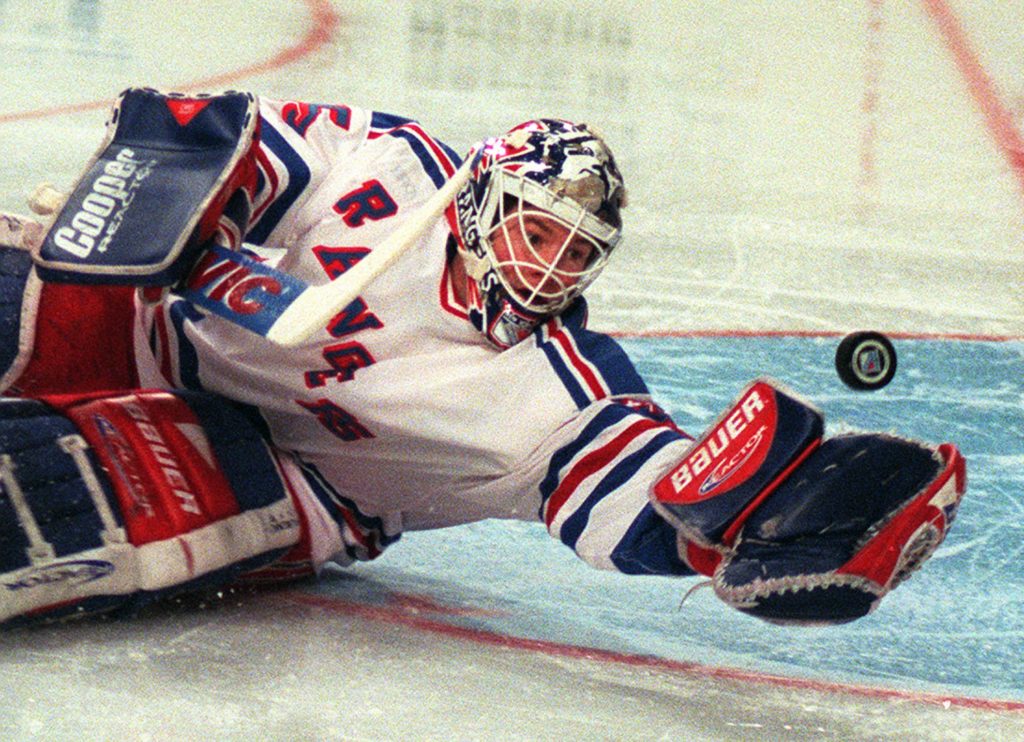
Ironic, isn’t it? A goaltender raised in the heart of Philadelphia Flyers country becomes one of the finest puck-stoppers in Rangers history. That would be tough for Hollywood scriptwriters to beat. But Mike Richter made that dream come true — and then some — as a New York Ranger.
To add to the miraculous tale, Richter had to beat out another New York hockey icon, John Vanbiesbrouck, to reach his pinnacle. Richter was drafted by the Rangers in the second round of the 1985 NHL Entry Draft, a sure sign that he was a highly thought of goaltending prospect.
Richter arrived at Madison Square Garden in the 1989-90 season and almost immediately pushed Vanbiesbrouck for the starting job. The following season, Richter posted a 21-13-7 record as he got his first extended look by playing in 45 games. He then proceeded to lead the NHL in save percentage during the 1990-91 Stanley Cup Playoffs with a .923 mark, including one shutout.
The next season, 1991-92, saw the Rangers win the Presidents’ Trophy and Richter was a key part of their dominance during the regular season. He split the starting job with Vanbiesbrouck and posted a 23-12-2 mark across parts of 41 games. The Blueshirts would again take home the Presidents’ Trophy during the 1993-94 season. In his first season as the unquestioned starting goaltender, Richter played in 68 games and posted a 42-12-6 mark.
But Richter’s ultimate claim to fame was that he led the Rangers to their fourth Stanley Cup in 1994. It was no easy task since he had to beat the inimitable Martin Brodeur in the seven-game third playoff round, considered one of the most keenly fought series of all-time.
JOHN VANBIESBROUCK
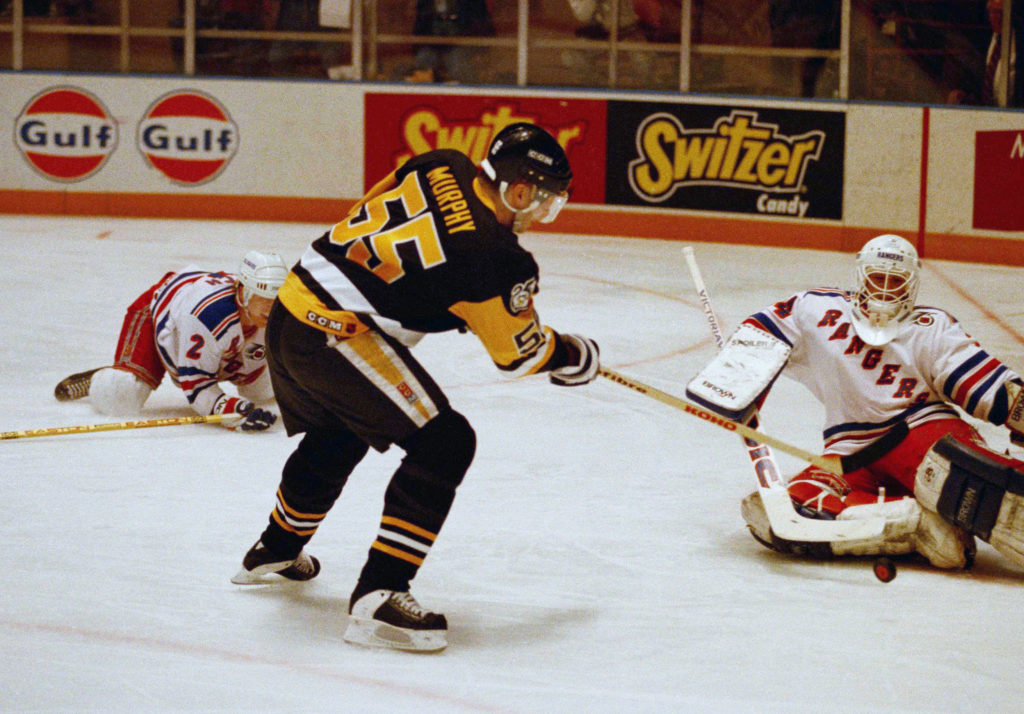
Like Eddie Giacomin before him, John Vanbiesbrouck touched a very pleasant nerve with Rangers fans. One could say that it was an instant love affair between the Faithful and the goaltender. Part of it had to do with a gut feeling and part John’s longtime link with the franchise.
Originally drafted by the Rangers, “The Beezer” starred on Broadway for more than 10 seasons. The 1986 Vezina Trophy-winner was eventually eclipsed between the pipes by a young Mike Richter, resulting in the Florida Panthers claiming John in the 1993 Expansion Draft.
As a young Ranger, Beezer needed time to acclimate himself to the NHL. He finished his rookie year with a record of 12-24-3 and then managed to dispel the “sophomore jinx” by winning the Vezina Trophy as the NHL’s best goalie for his work during the 1985-86 season. He also contributed to playoff upset victories over Washington and Philadelphia.
When then-Rangers general manager Neil Smith eventually had to make a decision between The Beezer and Mike Richter, Smith chose the kid and John headed south to Miami where his star still shone brightly. He won a Vezina, a first-team All-Star nod and one second. He also helped carry the expansion Panthers on one of the most improbable playoffs runs. Nearest miss is a four-game loss to the Avs in the 1996 Cup final.
LORNE WORSLEY
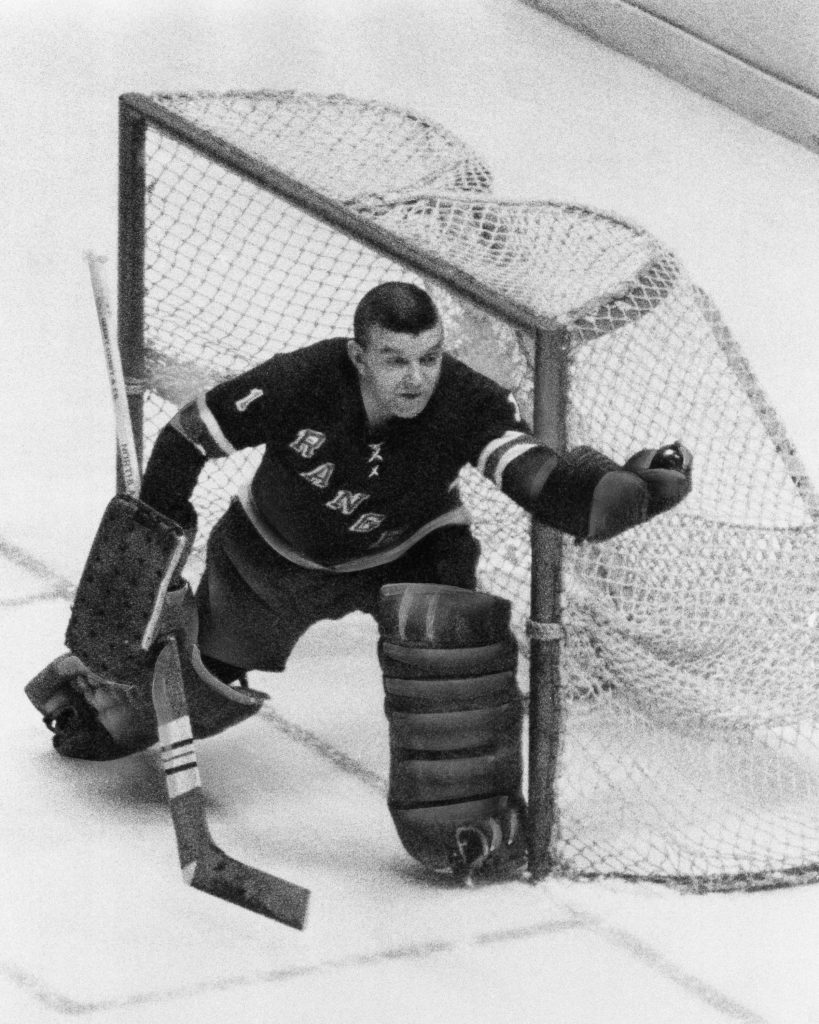
“Gump,” or “The Gumper,” as he was dubbed because of his likeness to a comic strip character named Andy Gump, was another of the much-admired netminders although his stint in Manhattan often was as rocky as it was roaring good. Discovered by the Rangers while Lorne played junior hockey in his native Montreal, Gump eventually was promoted to the Blueshirts’ New York farm club the Rovers and up to the Rangers in 1952.
His fearless performances while facing as many as 50 shots per game earned him the Calder Trophy as the NHL’s rookie of the year. Yet, inexplicably, Gump was promptly sent to the minors (Vancouver) for the 1953-54 season, replaced by Johnny Bower. This was a startling “reward” for fine play.
Andrew Podnieks, the author of, “Players — The Ultimate A-Z Guide of Everyone Who Has Ever Played in the NHL,” wrote: “Despite winning the Calder Trophy, he was back in the minors, spending the entire season with Vancouver of the WHL. As a result, he holds the ignominious distinction of being the only Calder winner to not play a single NHL game in the year after winning.”
Gump’s round, jowled face and watery, hound-dog eyes sometimes gave the impression of complete nonchalance as he flopped around the ice covering up for his teammates’ many blunders. Once, while playing for a terrible Rangers team in 1954-55, Gump was interviewed by a magazine writer. “Which NHL team gives you the most trouble?” Worsley was asked. “That’s easy,” dead-panned the Gumper, “the Rangers!”
By the 1955-56 season, Gump got the Rangers into the playoffs and did so for two more years despite constant battles with his nemesis, coach Phil Watson. Worsley’s comic-strip form became a fixture for New York’s hockey community until the summer of 1963. At the annual league meetings in Montreal, Worsley was traded to the Montreal Canadiens in exchange for Jacques Plante. It was then that Gumper achieved his goal; winning the Stanley Cup with the Habs.
